PinotFile: 6.17 February 26, 2007
|
Littorai Wines Age GracefullyThere is an old saw that has been floating around for years that California Pinot Noir doesn’t age. This has been propagated in part because Americans have little experience drinking aged Pinot Noir. The current vintages of Pinot Noir are often made to be consumed within a year or two of release and wine enthusiasts are encouraged to drink up before the next vintage. Upon release, Pinot Noir often heads straight to restaurants where thirsty consumers quickly deplete them from the wine lists. When have you seen any older vintages of American Pinot Noir on a restaurant wine list? The key to age ability for Pinot Noir is balance. If a wine doesn’t have balance to begin with, it will never develop it, and the wine will age poorly because the elements that are dominant become even more preponderant over time. Balance does not refer to aromas or flavors, but rather the relative levels of acidity, alcohol, tannin, and roundness that are felt in the mouth. A harmonious or wellbalanced wine has all of these elements in equal amounts with no one element dominant. Balance is a sign of quality and wines that are complete must have impeccable balance. The winemaking of Ted Lemon at Littorai is focused on balance and harmony. This can allow the wines to improve and blossom with cellaring. Lemon’s winemaking style avoids high alcohol levels and overripe flavors. Modest use of new oak is used for aging the wines as an element of complexity, but never leads one to think “oak” when tasting a Littorai wine. At Littorai, the goal is wines of elegance, length, and finesse and wines which gain in complexity as they age. With polished balance and proportion, the wines are uniquely suited to the dinner table at any stage of their evolution. Although Lemon honors the Burgundian tradition, he does not attempt to imitate Burgundy. He seeks the path between the excesses of many modern California wines and the vacuousness of others. Ted Lemon’s story is quite unique among California winemakers. The origins of his interest in wine can be traced to a study-abroad program at the University of Dijon in Burgundy while still a high school student. The director was so impressed with Lemon, he offered him a job if ever decided to take up winemaking. After graduating from Brown University, he was awarded a fellowship to return to France in the fall of 1980 to study viticulture and enology. He apprenticed in several famous Burgundy domaines including Dujac, Roumier, and Bruno Clair. When funds ran dry, he returned to the United States where he worked with Josh Jensen at Calera Winery. 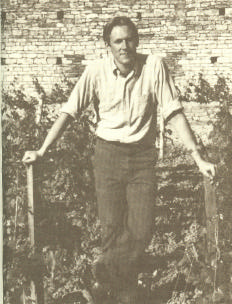 In 1982, while at Calera Winery, he was surprised by a phone call from Jacques Seysses of Domaine Dujac who asked him, “How would you like to make Meursault?” At Domaine Guy Roulot in Meursault, one of the oldest and most traditional wineries in Burgundy, Guy Roulot had died and his family was searching for another winemaker. The Roulot family sought the advice of Jacques Seysses. “Of all the apprentices I have had, and I have had many,“ Jacques Seysses told Madame Roulot, “none have been as bright and as capable as Ted Lemon. He has so many fine qualities, but there are two problems. He is 25-yearsold, and he is American.” Although Madame’s first reaction was “impossible,” after consulting with Aubert de Villaine, Patrick Bize, and others, she offered to make him the first (and to this day, the only) American winemaker and vineyard manager in Burgundy’s history. Lemon arrived at Domaine Roulot in 1983 (photo right). Because lemon spoke French fluently, he was able to assimilate and overcome the initial surprise and skepticism of the village people. He said, “At first I had to prove myself physically to the cellar and field help. I had to prune as quickly, drive a tractor as well, and work as hard as they could. And I had to prove to Madame Roulot, who was so devoted to Guy, that I could keep up the reputation of his wines.” Lemon made very good wines and quickly became accepted by the locals. After two years at Domaine Roulot, he was lured back to the United States by a French family that had purchased a vineyard on Howell Mountain above the Napa Valley. Their intent was to produce a French-style Chardonnay in California. The land here had been first planted in 1877 with vines from the Medoc region of France. Jean Adolphe Brun and W. J. Chaix were the original French owners and they built the Howell Mountain Winery on the property in 1866. It became Chateau Woltner in the mid-1980s and it was here, in 1985, that Lemon oversaw renovations of the aging winery and became the vineyard manager as well as winemaker. Chateau Woltner’s Chardonnays soon became a favorite among American wine connoisseurs. With his winemaking skills honed and assured, Lemon and his wife Heidi founded Littorai in 1993. He had spent a summer with his wife driving up and down the Pacific Coast tasting local wines and learning about the soil and history of the local vineyards. Lemon had a firm belief in terroir inspired by his years in France. According to Lemon, “I believe soil is of major importance in a wine’s character. It’s clear there are tremendous differences between wines made from vineyards right next to each other even if they are vinified and treated exactly the same way.” Finally, Lemon settled on sourcing his grapes from vineyards in western Sonoma and western Mendocino counties. He believed the finest Pinot Noir and Chardonnay were grown along the true coastal zone of the continent. He was convinced that the geology and mesoclimates of the extreme western portion of the continent north of San Francisco were diverse enough to create a series of unique terroirs, each with its own characteristics. He named his new venture Littorai which is a pleural noun formed from the Latin word litor-, which means the coasts. The word Littorai, with its reference to geography, reminds us that wine, the noblest agricultural product, arises from the weave of place (vineyard), time (vintage), and man.  Since the beginning, Lemon has sourced his grapes from independent growers and most on a “by-theacre” basis Littorai was the first modern California winery to create a “by-the-acre” contract for grapes. In these contracts, growers are paid for the quality of what they grow, not the quantity, The first contract was written in 1993 for One Acre Vineyard Pinot Noir in Anderson Valley. Such contracts have now become the norm for the greatest vineyards in California. Lemon closely supervises all aspects of vineyard management: pruning, composting, irrigation and crop yields. In 2003, 40% of Littorai’s producing acreage was estate grown (either under ownership or long term lease) and this percentage will increase in time. Beginning in 2003, over half of Littorai’s producing acreage is farmed using biodynamic and agro-ecological methods. Lemon has planted 3 acres of Pinot Noir behind his home in the Sebastopol hills (Dijon 667, 777 and California heritage selections) and has plans to plant 8 more. His first vintage from his home vineyard will be 2007. Lemon is a true winegrower, in that he is intimately involved in the entire winemaking process from planting and managing vines to corking and labeling bottles. As Lemon finds vineyards which have exciting potential, he plans to add them to the family and make them vineyard designates if they are truly unique. If he finds nothing new to excite him, he will simply not grow. By the same token, if he is dissatisfied with the quality of fruit from a given vineyard in a certain year, he simply will not produce it. Called declassification, it is a practice widely accepted and practiced in France. As Ted says, “This philosophy requires that our clients understand, as we do, that fine wine is not a commodity. We cannot simply invent more of it to satisfy demand. Indeed, that is what distinguishes it from its less expensive brethren.” In 2005, there were 924 cases of vineyard designate Pinot Noir and 720 cases of appellation Pinot Noir. Chardonnay production was 675 cases. The 2006 vintage was more giving and it is anticipated that there will be a total of 4,500 cases produced. Lemon does not own a winery, but manages the Black-Sears Winery on Howell Mountain in Angwin, Napa Valley. At this shared facility, he oversees the making of wines for Howell Mountain Vineyards, The Black Sears Estate, Reverie, and Littorai. He plans to eventually build his own winery on his 30- acre estate in Sebastopol which will put him closer to his vineyard sources in Sonoma and Mendocino. Lemon is beginning to build a legacy of younger winemakers who have apprenticed under him. These include the current winemaker at Saintsbury in Carneros, Jerome Chery, as well as Scott Wright of Scott Paul Wines in Oregon and Sam Tannahill of A to Z wines and Archery Summit also in Oregon. Doug Wisor, the head winemaker at Craggy Range, was one of Lemon’s protégés prior to his untimely death. The winemaking style at Littorai employs minimal intervention, long lees contact, and gentle handling of the fruit and wine at all times. Pumps and filtration are avoided as much as possible. All of the Chardonnays are barrel fermented. After a cold soak, the Pinot Noirs are fermented in traditional open-top fermenters containing from 800 to 1500 gallons. At least some proportion of whole clusters are utilized as dictated by the vintage. Punch down is by hand. All of the wines undergo native yeast fermentation and complete malolactic fermentation, as long as nature does not dictate otherwise. Aging is done in 30-50% new oak with medium toast for 16-18 months. I think patience is the key word here, as Lemon is a patient winemaker who works with the juice at hand, an artist guided by his taste more than science who avoids using new technology only for its own sake. Ted is a life-long winemaker passionately committed to his craft. He has not come into wine as a second career and this fact is essential to understanding Littorai. Littorai produces wines which adhere to a personal and passionate esthetic sensibility. Lemon is not motivated by competition, ratings or trends, or by the lure of publicity. He does not submit samples for scoring. Basically, his wines speak for themselves. His latest newsletter had this quote from Max Leglise at the top: “Good wines need no press secretary.” I recently had the distinct honor of interviewing Ted Lemon for a podcast to be broadcast on Grape Radio (www.graperadio.com) in the near future. I enjoyed meeting his family (3 children all under 10 years of age) and his lovely wife, Heidi (she runs the business side of Littorai). To commemorate this event, I sat down with the crew from Grape Radio (Jay Selman, Brian Clark, and Eric Anderson) and tasted through several older vintages of Littorai Pinot Noirs. I think you will be able to acquire a feel for our enthusiasm for these wines in the podcast as well as in my tasting notes that follow. Without exception, the wines had all aged extremely well and exhibited the lovely bouquets of Pinot Noir that can only come with aging: barnyard, dark chocolate, tobacco, exotic woods, and mushrooms. Every wine was balanced, understated (power with velvety softness), and had a certain Burgundian sensibility (good acid structure). The terroir really came through and individual vineyard differences were quite apparent. There was consistent excellence from vintage to vintage that was impressive. Not a bad wine in the lineup R.I.P for the old saw about a perceived lack of age ability of California Pinot Noirs. 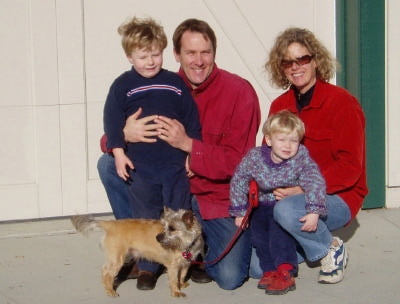
2004 Littorai Mays Canyon Russian River Valley Chardonnay 14.2% alc.. Brian’s favorite wine! Lemon says, “Great Chardonnay is one of the rarest and most exciting wines in the world.” By the way, Lemon also remarked in his recent newsletter that the current 2005 vintage may be the greatest for Chardonnay he has ever seen in 24 years of making it - equal or better than 1986, 1994, and 1995 in California and 1982, 1986, and 1996 in Burgundy! · Very Meursault-like. Beautifully balanced with an appealing mineral and citrus aftertaste. No buttery oak onslaught here. A charming wine that was drinking even better with more richness from the opened bottle eight hours later.
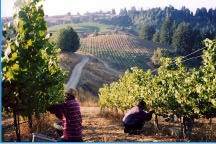 2000 Littorai Hirsch Vineyard Sonoma Coast Pinot Noir 14.2% alc.. Littorai was one of the first and most important purchasers of the famed Hirsch Vineyard and came to Hirsch at the same time as Burt Williams and Steve Kistler in 1994. Most producers who source fruit from Hirsch Vineyard do so from different blocks that are scattered over the hilltops and hillsides on the 1,100 acre Hirsch property. This arrangement means that no Hirsch Vineyard wines from different producers can be tasted and contrasted in the context of a proper terroir tasting in the Burgundian sense of the word. · A typical Hirsch with a big and expressive nose of dark stone fruits, exotic spices, and cinnamon. Big-boned and well-muscled, it is nevertheless, beautifully balanced and composed. The tannic edge to the finish will soften with further cellaring.
1999 Littorai One Acre Vineyard Anderson Valley Pinot Noir 14.4% alc.. Alas, One Acre Vineyard had to be replanted and the 2004 vintage was the last for several years. · This Pinot is a showoff. The alluring aromas of dark cherries, barnyard and dark chocolate lead you to plenty of dark Pinot extract in the mouth. The mid palate flavors are big and powerful, yet the wine finishes on a lengthy and delicate note of cherry fruit. This is truly a complete wine with everything in symphony. This wine makes the hair stand up on the back of your neck.
1999 Littorai Theiriot Vineyard Sonoma Coast Pinot Noir 14.3% alc.. Thieriot is my perennial favorite and the 2001 Littorai Theiriot Vineyard Pinot Noir was my Littorai epiphany several years ago. · A big, rich nose followed by a panoply of dark stone fruits, spice and a little tobacco. Reminds me of a wine from Nuits-St-George. This winner has a very plush mouth feel. Still a Lolita. Thieriot Pinots are like a Prom Queen: she smells great, is beautiful and is someone you could dance with all night.
1998 Littorai Savoy Vineyard Anderson Valley Pinot Noir 13.8% alc.. Littorai was the first winery to make a vineyard designate from Savoy Vineyard. Now there are multiple producers who purchase fruit from this special site. Lemon was also the first producer to clearly demonstrate the potential for fine Anderson Valley Pinot Noir beginning in 1993. He found that world-class production could be achieved here with low yields, proper clones, vertical trellising, leaf removal, and other farming techniques. · Very light in color and body, this wine blossomed beautifully with air time with more nose and punch than the ‘96. Soft and sweet red fruits are accompanied by dried herbs. The wine finished nicely with a hint of oak and cashmere tannins. Savoy reminds me of the shy and demure young lady in the corner, who, when she takes her glasses off and lets her hair down, everyone goes wow!
1997 Littorai Hirsch Vineyard Sonoma Coast Pinot Noir 14.1% alc.. · The Hirsch Vineyard Pinot Noirs are the biggest, boldest, earthiest, and most sinewy and tannic of the Littorai lineup. This 1997 Pinot still has perceptible tannins on the back end but they are dusty now. There is still plenty of flashy , ripe fruits with a definite underlying earthiness smokiness and minerality. I think this wine could go another 10 years.
1997 Littorai Theiriot Vineyard Sonoma Coast Pinot Noir 13.3% alc.. · This wine is showing a touch of yellowing around the rim. There are sweet dark fruits here highlighted by pepper, wet leaves and anise. The tannins have softened considerably and the finish is very clean with brisk acidity.
1996 Littorai Savoy Vineyard Anderson Valley Pinot Noir 14.3% alc.. · The two Savoys tasted here were lighter, more austere with a more notable acid spine than the wines from other vineyards. With swirling, the shy nose opened to bright and rich raisins, currents and exotic woods. A small touch of herbs highlighted the back end.
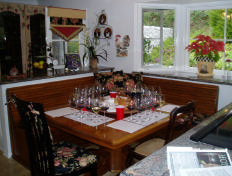 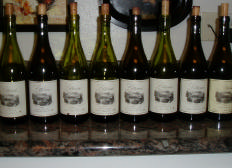 Littorai wines are sold only through a mailing list. As a testament to their quality, they are on the wine lists of America’s most prestigious restaurants. The website is www.littorai.com and the phone is 707- 823-9589. The 2005 Pinot Noir releases include: Sonoma Coast and Les Larmes Anderson Valley (both $42), Savoy Vineyard Anderson Valley($60), Hirsch Vineyard Sonoma Coast ($65), Mays Canyon Vineyard Russian River Valley ($65), Cerise Vineyard Anderson Valley ($65), Roman Vineyard Anderson Valley ($65), Thieriot Vineyard Sonoma Coast ($70), The Haven Sonoma Coast($75), and Summa Vineyard Sonoma Coast ($80). The three Chardonnays include Charles Heintz Vineyard Sonoma Coast, Mays Canyon Vineyard, and Thieriot Vineyard (all $60). Older vintages rarely come up for auction, but Littorai periodically releases previous vintages from the winery’s library, a practice that is rarely seen in today’s financial climate where wineries infrequently hold back significant amounts of previous vintages.
The New SaintsburyI was recently in Napa (I know, hard to believe), and stopped by Saintsbury to talk with the newest winemaker, Jerome Chery. I had been impressed with the 2004 vineyard-series Saintsbury Pinot Noirs. The 2004 Saintsbury Lee Vineyard Carneros Pinot Noir and the 2004 Saintsbury Brown Ranch Carneros Pinot Noir both made my 2006 “All-American” Pinot Noir teams. Somehow, I had never visited Saintsbury, although I have been a fan of their wines for many years. Saintsbury cofounders David Graves and Richard Ward celebrated their winery’s 25th anniversary last year. They were true pioneers in Carneros. After meeting in 1977 at University of California Davis where they were taking classes in enology, and realizing they had a shared passion for Pinot Noir, they started Saintsbury in 1981. This was about the same time as another well-known Pinot producer, Williams Selyem was starting out in the Russian River Valley (the winery is celebrating 25 years in 2007). They decided to stake their claim in Carneros and sourced all of their grapes from that appellation. Carneros had the right climate for Pinot Noir and Chardonnay, but the clay soils generally drained poorly and the low annual rainfall made water for irrigation very precious. Despite no real business plan and very little money, they took the plunge. They released 2000 cases of Pinot Noir from purchased grapes in 1981 and have never looked back. By 1991, production had increased to 35,000 cases and their Pinot Noir was on practically every restaurant wine list in the United States. Graves and Ward like to kid about their success, thankful because “Our attitudes and work habits make us otherwise unemployable!” 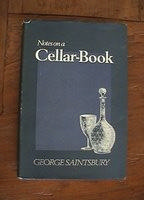
Saintsbury is named in honor of George Saintsbury, a journalist and Professor of rhetoric and English literature at the University of Edinburgh. He was also a wine lover and in 1920, at the age of 75, published Notes on a Cellar. This was an unusual collection of opinions and notes about wine and other alcoholic drinks as well as reminiscences about his wine cellar and wine dinners over the years. One of his famous quotes was: “It is the unbroken testimony of all history that alcoholic liquors have been used by the strongest, wisest, handsomest, and in every way best races of all times.”  Saintsbury owed its success through the years to offering a high quality to value ratio. In addition, the wines have been consistent from vintage to vintage and have offered elegant, ripe fruit with supple textures. The wines have gotten a bit riper in recent years, but have never gone too far to the dark side. Saintsbury has about 13 acres of vineyard around their unpretentious and weathered barn-like winery (photos on next page show winery and original plantings of Pinot Noir) and own the Brown Ranch Vineyard nearby, but they source most of their grapes from Napa Carneros growers through long-standing relationships. 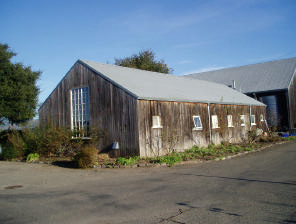 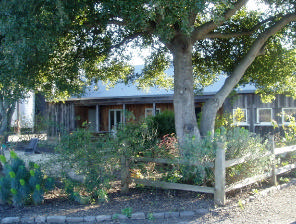 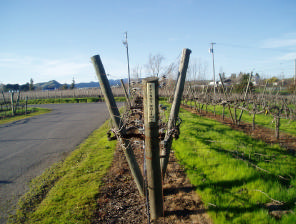 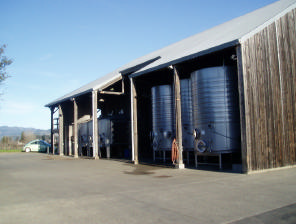 The legacy of Saintsbury will show the following distinctions: (1) They limited their production to Pinot Noir and Chardonnay and focused on one appellation only (Carneros became an American Viticulture Area in 1983), (2) They were one of the first to plant the Pommard clone of Pinot Noir (1986), (3) They were vineyard pioneers, using vertical shoot trellising in their vineyards at a time most vineyards were still either head-trained or used two-wire California sprawl, (4) They planted the Brown Ranch Vineyard in 1992 (23 acres of Pinot Noir, 8 acres of Chardonnay) using the newer Dijon clones 115, 667, and 777 along with Pommard, (5) They routinely avoided filtering their wines since 1989, and (6) They were one of the first wineries to produce a vin gris of Pinot Noir. They first made theirs in 1989 from a saignee of a portion of the crop to concentrate the wine and named it Vincent Vin Gris. Through the years, the Saintsbury lineup of Pinot Noirs has included Garnet, Carneros Pinot Noir, Reserve Pinot Noir, and since 1996, Brown Ranch Vineyard Pinot Noir. The Chardonnay program has consisted of a Carneros and in some vintages a Reserve Chardonnay. 
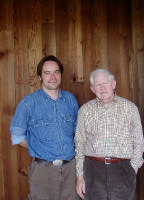 Over the last several months, I tasted through the entire lineup of 2004 Saintsbury Pinot Noirs. During my recent visit, I also sampled the 2005 vintage vineyard designate Pinot Noirs with Jerome. This was the first vintage that Jerome had complete control throughout the growing season to completion of the wines. He feels that 2005 was a better vintage than 2004 overall, and happily for consumers, there is more wine available. The wines were bottled in August of 2006, and will be pre-sold in March and officially released April 1 (no joke). Based on my tasting, I would allocate some space in your cellar for these magnificent wines. I liked them all and will certainly purchase some of each for my own future enjoyment.
2005 Saintsbury Brown Ranch Vineyard Carneros Pinot Noir Great stuffing here and a finish that is like wings on an angel.
2005 Saintsbury Cerise Vineyard Anderson Valley Pinot Noir The first vineyard-series Pinot Noir from the Anderson Valley. This vineyard is on a hillside near Philo, low-yielding with small berries. The challenge here is to tame the extraction. · This is a big and dark wine with dusty tannins on the finish. I would cellar this a year or two before indulging.
2005 Saintsbury Lee Vineyard Carneros Pinot Noir A supple mouth feel, good tannic backbone, very long finish. This will be a Oscar winner.
2005 Saintsbury Stanly Ranch Vineyard Carneros Pinot Noir Fruit-forward, lip-smacking, and ready now. Drink this one first.
2005 Saintsbury Toyon Farm Vineyard Carneros Pinot Noir Like a soft pillow, this beauty finishes clean with fine-grained tannins.
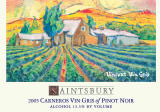 2005 Saintsbury Vincent Vin Gris 13.5% alc., $13. · Perfectly fine for a Pinot Noir rosé. A very light pink-orange colored wine whose structure and punch defies the faint color. The nose is appealing with orange peel, juji fruit, and anise and the flavors include strawberry and pomegranate. There is a little richness on the palate and tangy acidity.
13.5% alc., 16,300 cases, $20. 20% estate fruit. · Light in color, this is a fresh, early drinking style of Pinot Noir. There is a surprising amount of structure and heft with a substantial tannic backbone. There is noticeable oak influence, but plenty of fruit to counterbalance it. Alot of Pinot for less than $20, and an excellent daily drinker.
2004 Saintsbury Carneros Pinot Noir 13.5% alc., 21,400 cases, $30. Sourced from Lee, Toyon Farm, Stanly Ranch, Brown Ranch, and other Carneros vineyards. · This Pinot has a little more body and complexity than the Garnet. It is otherwise similar in being a fruit-driven style with deft oak and brown spice. A thoroughly decent quaffer, but I preferred the Garnet for drinking now.
2004 Saintsbury Brown Ranch Chardonnay 14.5% alc., $32. As an additional side note, look for my interview with winemaker Jerome Chery on Grape Radio. · An excellent wine with an appealing creamy texture. Topical fruits and bananas in the nose, butter and mineral highlights in the middle, and a clean finish. A very nice compromise between the big, oaky Chards and the more austere, stainless fermented Chards made in California today.
2004 Saintsbury Lee Vineyard Carneros Pinot Noir 14.5% alc., 2,850 cases, $45. This Carneros heritage vineyard is farmed by Ira Lee, now 85 years old. Pommard and Swan clones of Pinot Noir are included.. A beautiful wine that is just perfect. · The nose is rich with spicy cherries and vanilla and there is a magnificent complexity of flavors including cherry pie, herbs, tea, and Oriental spices. Very clean, silky in the mouth, and perfectly weighted. Superexcellent.
2004 Saintsbury Stanly Ranch Carneros Pinot Noir 14.5% alc., 4,560 cases, $45. Stanly Ranch Vineyard was originally owned in the 1950s by Louis Martini and the Wente family. It was here that the historic clonal trials of Pinot Noir and Chardonnay were carried out that became the source of Martini and Wente clones of Pinot Noir and Chardonnay that are widely planted in California today. In 2001, the vineyard underwent a modernization, with planting of modern clones, tighter spacing, and vertical trellising. Saintsbury has been sourcing grapes from Stanly Ranch since 1984 and Stanly Ranch grapes have formed the foundation of the Carneros and Reserve bottlings in the past. Saintsbury gets to “cherry-pick” the best vines. This Pinot contains 667 clone only. · A very nicely crafted Pinot with intriguing aromas of dark cherries, browned toast, and anise duplicated in the flavors. The wine finishes cleanly with lively acidity and lingering toasty oak aromas.
2004 Saintsbury Toryon Farm Carneros Pinot Noir 14.5% alc., 4,260 cases, $45. This vineyard sits on a property that was originally a horse ranch, and today, the owners Ed and Camile Penhoef run a dressage training facility adjacent to the vineyard. This vineyard is separated from Saintsbury’s Brown Ranch Vineyard by the famous Hyde Vineyard. · This wine is composed of 115 clone grapes I have tasted this wine twice. Several months ago I found it quite closed with aromas of mushrooms and earth dominating. There was appealing red fruits but with a herbal, astringent and tannic note to the finish. I tasted it again at the winery recently and the rough edges in the finish had disappeared. It showed very appealing Pinot fruits, a silky texture, and suede-like soft tannins on the finish. Perhaps it was the presence of the winemaker, but the wine honestly tasted significantly better the second time and presumably additional bottle age did the trick.
2004 Saintsbury Brown Ranch Carneros Pinot Noir 14.5% alc., 5,100 cases, $60. This is the flagship Pinot Noir in the Saintsbury lineup and is worth every penny. · It is the most stylish of the wines with a certain breeding apparent. This is a Pinot to spend time with as the aromas and flavors of cherries, black raspberries, currents, roses, cola, cinnamon, and damp leaves come and go with fascinating and ever changing combinations. The entire spectrum of Pinot fruits can be detected. The wine is light on its feet with very good balance. A true collectable that will hold your interest for years to come.
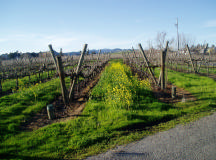
Joseph Swan Vineyards: A ClassicSometimes we have a tendency to get caught up in the “Pinot of the Moment” mentality where we chase the latest Pinot maker who has received a high score from one of the prominent wine critics. We often ignore our California heritage Pinot Noir producers whose pedigree is proven and worthy. Joseph Swan Vineyards is just such a producer. No marketing hype here, no samples submitted for scoring, no overblown wines made to satisfy the wine press. Just honest, good Pinot that reflects the sensitivities and goals of the winemaker. 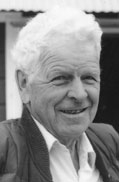 I have written extensively about the legacy of Joseph Swan (PinotFile, Volume 5, Issues 25 and 28). In 1967, at the age of 45, Swan was working as a Western Airlines pilot when he bought a run-down Zinfandel vineyard, barn and house on Laguna Road in the Russian River Valley. The house on the property had at one time been a general store for the tiny town of Trenton that is no longer in existence. The area, called the Laguna Ridges, is only a few miles from Westside Road, but the climate here is much cooler, foggier and wetter than the Middle Reach area to the north. He planned to farm grapes and make wine after his retirement. Swan began a replanting of the vineyard to Pinot Noir, Chardonnay and Cabernet in 1968. This was at the same time that Joe Rochioli planted his famous East Block of Pinot Noir at Rochioli Vineyard (although only a few miles apart, there is no written record that they knew much of each other’s intentions). The original Pinot Noir field clonal selection was from Mt Eden (via France, Paul Masson, and then Martin Ray). The vines prospered and produced very good Pinot Noir and the cuttings from the vineyard became widely distributed to other vineyards as the Swan clone or selection. There are now twelve different clones in the Joseph Swan Trenton Estate Vineyard, including some DRC suitcase clones given to Joe as a gift many years ago. The first vintage of Joseph Swan Pinot Noir was 1973 and was produced with consultation from the legendary Andre Tchelistcheff who was a friend of Joe’s. Subsequently, Swan made a string of outstanding Pinot Noirs from his vines. Despite their high quality for the time, Swan was such a perfectionist that he never was satisfied. He traveled to France every year to improve his winemaking techniques. He experimented with whole cluster fermentation, manual punch downs, and the use of new French oak barrels - all techniques that were unusual for California winemakers in the early 1970s. His legacy will include his popularization of the old, Burgundian winemaking methods, his search for better clonal material, and his openness to new idea. Joseph Swan passed away in 1989, but his legacy and vineyard lives on thanks to the talents of Swan’s son-in-law, Rod Berglund. Rod became a winemaker in 1979, largely due to Swan’s encouragement. Rod married Swan’s daughter, Lynn in 1986 and help Swan with his last harvest in 1987. He has taken over management and winemaking at Joseph Swan Vineyards and has continued the tradition of excellence that Joseph Swan was known for. The personification of Joe has been retained in the winery’s wine club which is called “Joe’s Drinking Buddies.” Rod has continued Joe’s espirit de core by maintaining the philosophy that “While consumers are demanding that wines deliver flavor, there seems to be a growing number of people who are embracing the concept of wines with food, who understand what it takes for wines to age gracefully, and who are looking for elegance and complexity instead of sheer power. The age of chocolate and vanilla may be coming to an end! Hurray for 57 flavors! It is a thrilling time to be a wine drinker.” I recently tasted two recent Joseph Swan Vineyards Pinot Noirs beautifully crafted by Rod Berglund. These are wines of great breeding that have a heritage at heart. I encourage you to sample and explore the wines of this legendary producer. The wines produced here also age extremely well. The 1999 Joseph Swan Vineyards Mancini Ranch Zinfndel is just now entering into its peak stage of drink ability and should hold at this level for many more years. A few case are still available at the winery.
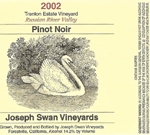 2003 Joseph Swan Vineyards Cuvée de Trois Russian River Valley Pinot Noir 13.6% alc., $23. This is the most popular wine in the winery’s lineup and sells out quickly after release each year. The first year of production was only 100 cases, but this has gradually been ramped up to 1,100 cases. It is a blend of lots including grapes from the young vines of the estate Trenton Vineyard and other vineyards including Saralee’s Vineyard. It is meant to be an easy drinking Pinot from the time of release and is not as complex as the vineyard designates. · What a nice surprise! Very lovely berry, raspberry tea and spice aromas and flavors. The aromatics are flat-out terrific. Not at all overblown, no alcohol or tannins to spoil the party. Very good acid kick at the end. If you like Pinot Noir, this is your cup of tea.
2002 Joseph Swan Vineyards Trenton Estate Vineyard Russian River Valley Pinot Noir 14.2% alc., $40. · Terrific aromatics with a little spicy cherry, cola and toast. Nicely-weighted pure, sweet fruit with a gentle oaky edge and a lively finish uplifted by bright acidity. This wine is not a voluptuous wine in the full-throttle California sense, but it is thorough satisfying and really what Pinot should be but so often falls short. Not surprisingly, it is a winner with food.
Joseph Swan Vineyards has just announced their 2007 Spring releases. There are three Pinot Noirs offered: 2004 Cuvée de Trois, 603 cases ($24), 2004 Great Oak Vineyard, 96 cases ($35), and 2004 Trenton Estate 327 cases ($45). No allocations here, but the wines do sell out quickly. 10% discount is offered on case purchases. There are also Zinfandels of great merit. The informative website is www.swanwinery.com, and do sign up for the newsletters which are well written by Rod Berglund. The phone is 707-573-3747. The tasting room is open from 11:00 to 4:30 Saturday and Sunday and Monday and Friday by appointment.
Saxon Brown WinerySaxon Brown Wines has been around for ten years now. Owner Jeff Gaffner (yes almost the same last name as mine) made 210 cases the first year after leaving Chateau St. Jean where he spent 15 years. Saxon Brown is now thriving, and Jeff has to laugh about the old days. Besides Pinot Noir, he makes a Semillon (from Alexander Valley) several Syrahs (from Sonoma Valley) and Zinfandels (from Sonoma Valley). I had a Saxon Brown Pinot Noir in the late 1990s that I thought was terrific and have kept the winery in my radar ever since. The latest releases are the 2005 Durell Vineyard Hayfield Block Sonoma Valley Pinot Noir ($48) and the 2005 Parmelee-Hill Sonoma Valley Pinot Noir ($38). The two vineyards are very close together and planted at the same time with the same clones and rootstocks, yet the sites and wines have their own personality.
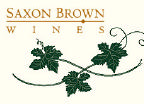 2005 Saxon Brown Durell Vineyard Hayfield Block Sonoma Valley Pinot Noir 14.5% alc., 99 cases, $48. Winemaking is traditional with a three day cold soak, slow fermentation, pressed to barrel after 14 days, racked off of the lees after malolactic fermentation, and returned back to the same barrels for 10 months of additional aging. · There is noticeable oak in the nose and on the finish upon opening, but with air time, the oak merges into the background. Aromas of spicy Bing cherry remind me of good Russian River Valley Pinots. This is a very tasty styled wine with plenty of sweet cherry liquor, tea and soy. The texture is soft as a down pillow. The whole package finishes with a cherry kiss.
Saxon Brown Winery address is PO Box 1832, Sonoma, CA 95476. The phone is 707-939-9530 and the website is www.saxonbrown.com.
Breggo Cellars: Join the FlockBreggo is a new winery in the Anderson Valley. The word Breggo means ‘sheep’ in Boontling, the private language Anderson Valley locals used in the late 19th and early 20th centuries. Boontling uses the syntax of English, but replaces parts for wholes and refers to things by their uses. For example, Boonville was referred to as “Boont,” people living around Boonville were “Boonters,” Philo was “Pleeko,” good food was “bahl gorms,” and “seeps’n’chiggle,” was good wine. The Breggo estate is a 203-acre farm located just north of Boonville. It was a former sheep ranch and the sheep, like Pinot Noir vines, found the inhospitable cool climate to their liking.  The co-proprietors and husband and wife are originally city folk. Douglas Ian Stewart is a native of Sonoma who found early success producing Brazilian sorbet. Ana Lucia Benitez-Stewart hails from Ecuador where her family had a dairy farm that she visited in the summertime from her home in Quito, but she had little interest in farming as a career. She found an exciting string of jobs that included being a park ranger at the Galapagos Islands and tour guide in the Amazon. Douglas proposed on a hillside in the Anderson Valley and now they too have come back full circle to a setting in the countryside of Mendocino County. Plans to start a vineyard on the property have been momentarily derailed, but a winery has been built and wines are being produced from purchased grapes. Pinot Noir is sourced from three well-known Anderson Valley vineyards: Ferrington, Savoy, and Donnelly Creek. The consulting winemaker is Ryan Hodgins, a U.C. Davis trained vintner who also makes wines at Hanzell Vineyards in Sonoma. 
2005 Breggo Cellars Anderson Valley Pinot Noir 14.5% alc., 679 cases, $35. Sourced from Donnelly Creek vineyards near Boonville. Pommard, Stang and Dijon 113 clones. · The nose is subdued but offers black cherries and cinnamon. The mouth feel is rich with copious dark Pinot fruits, tobacco and anise. The lengthy and smooth finish echoes oak.
2005 Breggo Cellars Ferrington Vineyard Anderson Valley Pinot Noir 14.8% alc., 193 cases, $50. Both Wadenswil and Dijon 777 clones. · The aromas of ripe cherries and toasty oak are shy and alcohol peeks out. The texture is fat and opulent with plum and black raspberry flavors and sweet oak. There are prominent oak tannins on the backend which smooth out some with air time.
2005 Breggo Cellars Savoy Vineyard Anderson Valley Pinot Noir 14.9% alc., 165 cases, $50. Martini 15, Pommard 4, Dijon 115 and 667 clones. · This is a full-throttle Pinot for those who like their wines fat in the mouth. There is high alcohol but it is never apparent as there is sufficient acid and fruit to bring everything into balance. This one fills the mouth with Pinot pleasure and finishes beautifully.
Breggo Cellars is located at 11001 Highway 128 in Boonville, CA 954115. The phone is 707-895-9589 and the website is www.breggo.com. The wines may be purchased on the website. There is retail distribution as well through Springboard Wine Company (Sybil Ajay) at 415-516-5988.
Napa Pinot Noir is No MisnomerFor years, Napa has been synonymous with Cabernet Sauvignon (or car parts as the Sonomans like to say) and Sonoma County has been associated with Pinot Noir. But Napa has also been caught up in the Pinot Noir craze. How could they ignore the fact that Pinot Noir is the fastest-growing varietal in this country. According to Impact Databank, Pinot Noir consumption is expected to rise 30% to nearly 3.75 million cases in 2006. Truth be known, the Napa portion of Carneros and some mountain vineyards in Napa County (Mayacamas Vineyards, Kuleto and El Molino for example) have been producing Pinot Noir for years. In addition, many wineries in Napa Valley own vineyards in, or source grapes from, Napa Carneros, and belong to the Carneros Wine Alliance (see map). A newer development finds some of Napa’s most visible Cabernet producers spending small fortunes to play the Pinot Noir game. Prominent among these are Phelps, Pahlmeyer, and Del Dotto along the true Sonoma Coast The Los Carneros appellation is split about in half with both Sonoma and Napa portions. On Ramal Road in Carneros, this is noted by a sign drawn on the pavement (photo). 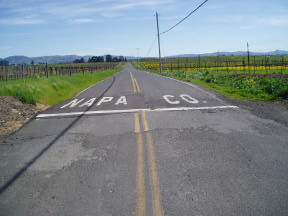 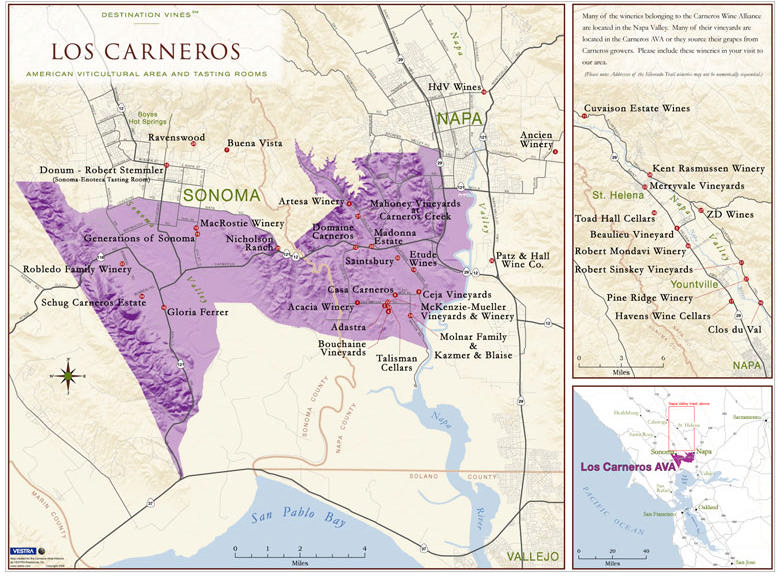 I have compiled a partial list of the wineries in Napa that produce Pinot Noir. Wineries in Los Carneros Acacia Wines, Artesa Vineyards & Winery, Adastra, Bouchaine Vineyards, Carneros Creek, Casa Carneros, Ceja Vineyards, Domaine Carneros, Etude Wines, Kazmer & Blaise, Madonna Estate, Mahoney Vineyards, McKenzie-Mueller Vineyards & Winery, Molnar Family, Saintsbury, Talisman Cellars, and Truchard Vineyards. Other Napa Wineries producing Pinot Noir Abiouness Wines, Ancien Winery, Anderson’s Conn Valley Vineyards, Andretti Winery, Arger- Martucci Vineyards, August Briggs, Barnett Vineyards (Santa Lucia Highlands), Beaulieu Vineyard, Beringer, Cakebread Cellars, Cartlidge & Browne, Caymus Vineyards (Belle Glos), Cliff Lede Vineyards, Clos Pegase, Cosentino, Cuvaison Estate Wines, Del Dotto Vineyards (Sonoma Coast), DomaineChandon, Duckhorn Vineyards (Goldeneye), Dutch Henry Winery, Elizabeth Spencer, Elkhorn Peak, El Molino Winery, Flora Springs, Franciscan Estates, Hagafen Cellars, Joseph Phelps Vineyards, Judd’s Hill, Kent Rasmussen Winery, Kuleto Estate Family vineyards, Louis Martini, Markham, Mario Perelli-Minetti Winery, Mayacamas Vineyards, Miner Family Vineyards (Santa Lucia Highlands), Merryvale, Monticello, Patz & Hall, Phelps (Sonoma Coast), Peter Michael Winery, Reynolds Family Winery, Robert Mondavi Winery, Robert Sinskey Vineyards, Signorello Vineyards, Sterling, Sutter Home/Trinchero, Toad Hall Cellars, Twomey, V Sattui Winery, Villa Mt Eden, and ZD Wines. Besides the “pinofication” of Napa, there is an ongoing “napafication” of Sonoma. Sonoma used to be very laid back and rural, some might say unsophisticated, and people in Sonoma relished their lifestyle. Healdsburg, however, now personifies everything that St Helena does, with high-end restaurants like the Dry Creek Kitchen and Cyrus, luxury hotels like Hotel Healdsburg and Les Mars, and chic boutiques that rival any along Highway 29. Tina Caputo, writing in the San Francisco Chronicle recently, pointed out that visits to Sonoma wineries are increasing and Sonoma is attracting more of the high-end travelers of the type that always headed for Napa. She quotes vintner Jeff Mayo who predicts that Napa and Sonoma will someday be thought of as a single wine region. Mayo said, “People used to only say ‘Napa’ or ‘Sonoma,’ but now I hear people saying ‘Napa-Sonoma.’ The Napa portion of Carneros remains more Sonoma-like (see photo), while the Sonoma portion of Carneros is becoming more Napa-like (note the new spectacular Jacuzzi Winery on Hwy 121). 
2007 International Pinot Noir CelebrationThe IPNC in McMinnville, Oregon, is the granddaddy of all Pinot Noir festivals, now celebrating its 21st year. Set on the campus of bucolic Linfield College, this collegial celebration of Pinot Noir is eagerly attended by pinotphiles, wine educators, winery owners and winemakers who freely mix, speak Pinot, and dine outdoors with meals prepared by some of our country’s most prominent chefs. This year’s event will be held on July 27-29. A grower Champagne Seminar headlines the 2007 IPNC featuring noted wine personalities Eric Asimov, Ghislain de Montgolfier, Rollin Soles, and Becky Wasserman. On July 27, there will be a tasting of sparkling Pinot Noir titled “The Secret Life of Pinot Noir: A Walk on the Sparkling Side.” The role of Pinot Noir in the wines of Champagne is often overlooked and this year’s celebration will provide a fresh look at the diversity of this well-loved sparkler. America has developed quite a thirst for grower Champagnes due largely to the fact that they are grown and vinified by hand, by producers who carefully oversee the grapes’ evolution from vineyard to bottle. The process is similar to that found in most small Pinot Noir wineries in Burgundy and Oregon, ensuring that the winemaker’s hand is involved in each step along the way. Oregon winemakers are also planning a toast to IPNC 2007 Master of Ceremonies Georg Riedel, who will unveil his new Oregon Pinot Noir glass. Fifteen French winemakers will showcase their wines this year, more domains than ever in IPNC’s history and more than any other Pinot festival. The IPNC is known for its exceptional cuisine. Featured chefs include Stephanie and Rocky Maselli of Marche Restaurant, Sue McCown of Coco la ti da, Mark Hosack of Hudson’s Bar and Grill, and John Sundstrom of Lark. Of course, Frank Ostini of the Hitching Post will head up a team for Saturday night’s Salmon Bake as he does every year.

Dundee Hills Passport TourOn Saturday and Sunday, March 17 & 18, 2007, the Dundee Hills Appellation will sponsor a Passport Tour through “The Heart and Soil of Oregon Wine.” There will be multiple free seminars at wineries and vineyards given by experts on the unique climate, red volcanic soil, geology and earth-friendly farming practices that make the Dundee Hills appellation so special. Participating wineries will offer tastings for no or minimal fees and include Archery Summit, Argyle Winery, Bergstrom Vineyards, Cottonwood Winery, Black Walnut Vineyard, DePointe Cellars, Domaine Serene, Domaine Drouhin Oregon, Dundee Manor, Durant Vineyards, Erath Vineyards, The Eyrie Vineyards, The Four Graces, Juliard Vineyard, Knudsen Vineyards, Lange Estate, Murto Vineyard, Rambouillet Vineyard, Sokol Blosser Winery, Stoller Vineyards, Thistle Wines, Torii Mor Winery, White Rose Wines, Wine Country Farm Cellars, and Winter’s Hill Vineyard. Log on to www.dundeehills.org to download a Dundee Hills Passport and map. Visit four or more wineries and seminars over the weekend and receive a stamp from each. Leave the completed Passport at the last stop and enter to win great prizes from the Dundee Hills.
Alicia Tapp DesignsA talented artist imprints wine photos, wine scenes, wine labels and vintage posters onto marble tiles, glass tiles, and ceramic plates. These unique tiles are perfect for a wine cellar, a backsplash in a kitchen, or the trim around a swimming pool! Really, your unbridled imagination can work wonders with these tiles. Check out www.AliciaTappDesigns.com. 
Gary Farrell Strikes Out On His Own AgainGary Farrell wines of the mid 1980s were fine early examples of Russian River Valley Pinot Noir. After making his first wines at Rochioli Vineyards and Davis Bynum, Farrell started his own label in 1982. His first Pinot Noir was 50 cases of a blend of Rochioli West Block and Allen Vineyard and sold for $80 a case! His 1985 Pinot Noirs, which offered elegance yet intense flavors, really spurred my enthusiasm for the potential of California Pinot Noir. I was saddened to hear that he sold his winery to spirits giant Allied Domecq in 2004. The current owner is Beam Wine Estates. One of his early labels is pictured below. Farrell is now 54 years old and has decided to partner with Bill Hambrecht and build a new high-end Pinot Noir winery in Forestville, just a short distance from his present winery on Westside Road. He had difficulty working under corporate ownership of his winery. Beam Wine Estates, which will retain the Gary Farrell name for their winery, is fully understanding of Farrell’s drive to be independent once again. Farrell will be retained for a period as a consulting winemaker.  The new winery is expected to be finished in 2009 and produce about 6,000 cases from long-term vineyard contracts that Farrell has accumulated over the years. The initial wines will be made at Hambrecht’s Belvedere Winery near Healdsburg while the new winery is built. |